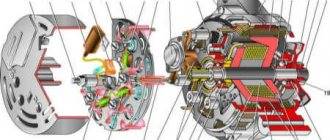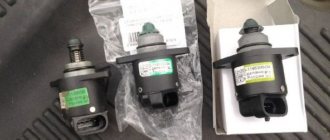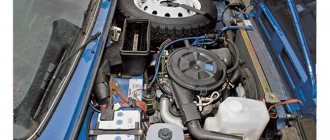It all started back in 1970, when Chairman of the Council of Ministers of the USSR Alexei Kosygin, as part of the program “blurring the line between city and countryside,” set the teams of VAZ, AZLK and Izhmash the task of creating a comfortable SUV for residents of rural areas.
This is how the VAZ-2121 changed in the process of developing the design and improving the design
The first experimental VAZ-E2121 saw the light of day in 1971. Moreover, his appearance was very far from what we have become accustomed to for forty years. In fact, it was a chassis with a simple tail, on which the concept of a new car was developed - the SUV did not have a frame, which at that time was considered an unheard-of design audacity. Initially, the car was planned to be equipped with a powerful diesel engine, final drives, rear torsion bar suspension and even a tire pressure regulation system, but later they decided to create a simpler version with a high degree of unification with the models already produced by AvtoVAZ, which was economically justified. This prototype allowed the design bureau under the leadership of Peter Prusov to significantly reduce the time needed to create the car. Is a 1.6-liter engine enough, is the gearbox reliable enough, does the car require a center differential lock and downshifts? The answers to all these questions were obtained thanks to the VAZ-E2121. It is interesting that the tests of the car were carried out in the strictest secrecy, and when asked by those interested, the factory workers answered that they were testing a new Romanian SUV.
The VAZ-2121 appeared in a form close to the serial one in 1972. The artist Valery Semushkin worked on the design of the new car. The car, according to the designer’s plan, was supposed to suit residents of both cities and villages. Both a collective farmer transporting his produce to the city market and a worker who decided to go out into the forest to pick mushrooms should feel equally comfortable in it. And since, according to the technical specifications, the car was supposed to have a relatively small trunk, the spare tire, in order to save space, was placed in the engine compartment. At that time, placing the spare wheel on a remote bracket behind the rear door was considered unsightly. In 1973, the VAZ-2E2121, which looked almost like the well-known Niva, was sent on a test run across Central Asia, after which it acquired a headlight cleaner and a rear wiper. An ahometer appeared on the instrument panel, which allowed the driver to monitor the speed when driving in the downshift range of the transmission. In 1974, the car was put up for state tests and in the same year received its own name “Niva”, which was patented. It is interesting that at that time there was no GOST for testing this type of car. After all, the standard testing scheme for SUVs for the Niva was too harsh, but for passenger cars it was the opposite... In the end, they decided to combine both programs, taking into account the versatility of the car. Based on the test results, the car received recommendations for mass production and export. True, before being put on the assembly line, the car received some more improvements. So, the rear “three” lights were replaced with “six” ones, and the headlights were taken from the “six”. The chrome bumper gave way to an aluminum one. A second outside rear view mirror has appeared. The first pilot batch of 50 vehicles was sent to the regions for controlled operation. Representatives of the plant constantly supervised their new product, which made it possible to identify several more “sores”, which were eliminated by April 1977, and the Niva entered the assembly line.
In addition to sales at home, Niva was actively promoted in foreign markets. Over forty years, more than 500 thousand SUVs were sent abroad. This unpretentious, but at the same time quite comfortable SUV has attracted buyers in more than 100 countries around the world. Importers actively re-equipped the car, making it into pickup trucks, convertibles, and styling it according to fashion. In addition, assembly of the model was established in Brazil, Greece, Canada, Panama, Chile, and Ecuador. The Niva was even exported to Japan, becoming the only Soviet car officially sold in this country. By the way, the Japanese, paying tribute to the general designer of Niva, gave Pyotr Prusov in 1986 an advertising brochure for their future Suzuki Vitara with the inscription “To the Godfather of this car.”
In 1978, the VAZ-2121 was awarded a gold medal and recognized as the best car of its class at the international exhibition in Brno. “Niva” has a lot of records. So, in 1998, Niva climbed Mount Everest under its own power, to a height of 5200 meters, in the same year, being dropped by parachute, it ended up in the Arctic and reached the North Pole under its own power, and the next year climbed to the Himalayas to a height of 7260 meters. She also visited Fuji. The reliability of the car is also evidenced by the fact that the production car was able to operate without serious breakdowns for 15 years in Antarctica at the Bellingshausen station. And this is in the complete absence of roads. Niva has a lot of sporting achievements to its credit: multiple participation in the Paris-Dakar rally, Atlas rally, Cameroon Rally and other achievements.
In 2001, the history of the VAZ-2121 as a Niva ended. The holder of the exclusive license for the Niva trademark was the GM-AvtoVAZ joint venture. But the history of the car itself continued and continues under the name LADA 4X4.
1998. “Niva” visited both Antarctica (1990) and the North Pole (1998), more than once conquered peaks under its own power and won victories in marathon rallies
1999. In 1999, "Niva" rose to a height of 5726 m in the mountains of Tibet. Before this, wheeled vehicles never rose to such a height under their own power.
Importers advertised the VAZ-2121 in every possible way in their periodicals; in addition, some of them allowed themselves to adapt the car to their markets through modifications
FOR 40 YEARS, THE LADA 4X4 HAS BEEN ON THE CONVEYOR OF THE VOLGA AUTO GIANT. MANY THINK THAT SHE HAS NOT CHANGED AT ALL DURING THIS TIME. WELL, WE HOPE TO DISCONCEIVE YOU ABOUT THIS. AND HERE WE WILL ONLY GIVE THE MOST NOTICEABLE CHANGES. IF WE'RE TALKING ABOUT SMALL MODERNIZATION, THERE WAS SO MUCH OF IT DURING THIS TIME THAT IT WOULD BE ENOUGH FOR MORE THAN ONE ARTICLE.
Niva with carburetor engine
There are actually two of them. If not more, but we will not pay attention to very exotic cases.
Niva VAZ-2121 . On the one hand, this is like a generalized brand of car, but this designation has a very specific car, the same one that was presented at the 25th Congress of the CPSU back in 1976, and since 1977 has gone into large production.
1.6-liter carburetor engine from the VAZ-2106 and has now become almost a rarity. Although there are quite decent, preserved or well-restored specimens. The engine is as simple as a stool in a school labor class, it is widely known to everyone (at least to people of the older generation), and nowadays it’s even scary to look under the hood of this car, there is so much free space.
Niva VAZ-21213 . Put on the conveyor in 1993, it is actually a restyling of the old 2121 and is equipped with a 1.7-liter model 21213. The engine is quite improved compared to the 2106, noticeably more powerful, a carburetor of the Solex family is installed, in contrast to the previously used classic carburetor of the "Solex" type. Weber”, as well as an electronic contactless ignition system. In this form, the Niva lived until the era of the injector, as the fuel injection system is commonly called. It’s not difficult to buy such a car even now, so it’s worth focusing on it if you choose the carburetor option.
Recommendations
Comments 13
In our family we had Nivas from 1987, 2000 and Nivas from recent years (grandfather changes them every 3 years). Niva '87 is a beast of a car. 150 km/h at 4 mortar, V-1600. Of course she periodically demanded attention. Both the body and all the mechanics. I also really liked the Niva 2000 (at that time it was 8-9 years old). It broke very rarely. At that time, my father took it in the north (they don’t pour salt on the roads there). I looked through a lot of them. Everyone was painted. I chose the dirtiest one. It stood in a guy's garage and was used for his summer cottage. Mileage 60 t. km. Well, about injection fields. Good devices. More comfortable, BUT on the vase they strangled Nivov engines with EURO requirements. She just became stupid. I don't know what to do with this. It can flash the brains, or it can stop worrying and take the carburetor. I would try to get a 5-6 year old carburetor.
About 2 years ago, my friends took the Niva. One took a new one from the showroom, and the other took a 1-year-old one, but well stuffed with “craftsmen”. In the “stuffed” one they made noise reduction, covered the interior with leather, installed different seats, installed electric windows and little things. Both comrades are as happy with the Niva as boas. The first one exploited and did not invest, except for consumables and maintenance, and the second did not invest anything at all (only gasoline). Of course, they didn't kill them off-road. Mostly around the city and to the dacha. Without fanaticism. The third acquaintance owned an old Niva (88-89, I think). He was also happy as a boa constrictor, but after going hunting he drove him into the hole and always changed something. He complained that spare parts were expensive and their quality was not so good. I went to tune the carburetor several times. Each time I was not very happy with the result. Either it was running out of fuel, then it was stalling, or some other nonsense. In general, an old car is an old one that requires attention and constant “care”. Therefore, I am for the 3rd option. Save up and take Shniva or at least Niva for no more than 1-2 years. They already come with power steering, it’s becoming more and more pleasant to turn the steering wheel. You can take the old one, in some ways it may be better than the new one, but it will take a lot of time. It may not even be so much a financial investment as a temporary one.
Essentially, the difference in quality for cars up to 150 thousand. not noticeable. The Niva was modified and improved several times. I was once puzzled by this question as well. The main thing, of course, is simply the condition of the car, but if we take all things being equal, there are differences between 2121 and 21213. As an exhibit, 2121 is of course an excellent option, but if you drive on modern roads, then of course 21213, or better yet 21214-) What is the difference? 1. The volume and power of the engine, on the 2121 it is 1600 cm3, for that 4speed gearbox and axles this is enough, for those who like leisurely driving too -) On the 21213 the engine is more powerful, the axles are wider, the 5speed gearbox, everything is done for a more dynamic ride without loss of properties off-road. In terms of bodywork, the differences are more obvious. 2121 older and slow-moving cars, for lovers of antique cars. For regular use, 21213 is better if the car is in the same condition.
If you’re just going for a ride, then you can use a Niva from the 80s, but if you want a new one, maybe the old ones are essentially Youngtimeri) if you want a carburetor, take the 21213 from the 90s.
I don’t want a carburetor at all :))) why is 21213 better than Soviet cars? I read on the contrary that after the 90s the quality dropped.
Nothing better, just if you want 21214, but the carburetor is 21213. It’s simply a pity to rape the Soviet field.
Chevrolet Niva is not worth the money. A relative took a 1988 Niva and has no complaints.
why is the shevik not worth it? 2005 - 200 tr., 2010 - 340 tr. and above, something like this, what are the alternatives? I like that they are all injection, unlike 3 doors and 5 doors though











